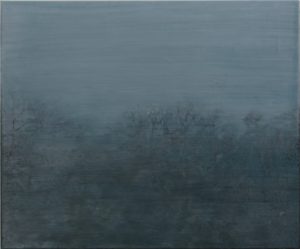The works in this series, Deep Rhyme – The Note of Water started as watercolor in 2012 on Hahnemühle paper with charcoal and gouache and eventually developed into oil paintings. In her works, she represents her momentary encounters as pictorial experiences. For example, the moment she was suddenly enveloped by mist in the middle of forest or the moment she witnessed the reflection of her surroundings on a thin layer of fallen sleet on the surface of temple garden pond in the early morning. We can see from the subtitles of her works, like Sleet, Thin Ice, and Drizzle, that the existence of water in its various forms is an important subject for Kodama.
Kodama produces her paintings in her own unique style by repeatedly layering. Deep Rhyme – The Note of Water also begins with a first layer creating a concrete background. She lays the work on the ground and right before the paint dries, she covers the whole thing with another thin layer of paint. She adds additional paint onto different parts or exposes the layers of colors that lie underneath. This complex artistic process is repeated over and over again. For this series, she used pearl pigments to capture the quality of the air enveloped by mist. The final condition of the image is often affected by how the paint dries in the different temperatures of the seasons, the relative gravity of the paint or the subtle wrinkles in the canvas. The characteristics of the paint induce a semi-accidental phenomenon as the painting comes into existence. When she looks upon her finished work, and she calls upon those unusual feelings which were the catalyst. Has she created her own pictorial experience or recreated her experience in nature? She says she doesn’t know. Kodama’s work exists in the gap between the phenomenon that is brought out by the unique physical properties of paint and the pictorial reality woven by the artist. Kodama states that “there are things in this world that can be seen and cannot be seen. This fact and the act of my painting exist simultaneously, and this is where I belong.”
Installation view






























